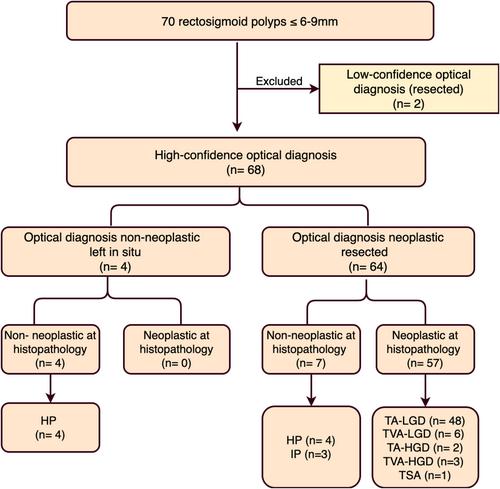Implementing narrow banding imaging with dual focus magnification for histological prediction of small rectosigmoid polyps in Vietnamese setting
Abstract
Background and Aim
Small rectosigmoid colorectal polyps (<10 mm) are prevalent, with a low prevalence of advanced neoplastic lesions. The “diagnose-and-leave” strategy, employing narrow band imaging (NBI), is gaining popularity for its safety and cost-effectiveness by reducing polypectomy complications and minimizing histopathology expenses. This study assessed the diagnostic efficacy of NBI with dual focus (DF) magnification for real-time neoplastic prediction of rectosigmoid polyps and explored the feasibility of implementing this strategy in Vietnam.
Methods
In a prospective single-center study, 307 rectosigmoid polyps from 245 patients were analyzed using three consecutive endoscopic modes: white light endoscopy (WLE), NBI, and NBI-DF. Endoscopists assessed polyps for size, location, macroscopic shape, optical diagnosis, and confidence levels before histopathological evaluation. High confidence was assigned when the polyp exhibited all features of a single histology type. Predictions were compared with final histopathology results.
Results
Of the total, 237 (77.2%) were diminutive (≤5 mm) polyps, and 18 (5.8%) were advanced neoplastic lesions. WLE + NBI and WLE + NBI + NBI-DF exhibited significantly higher accuracy compared to WLE (88.6% and 90.2% vs 74.2%, P < 0.01). For diminutive polyps, the DF mode significantly increased the rate of high-confidence optical diagnoses (89.1% vs 94.9%, P < 0.001). WLE + NBI + NBI-DF demonstrated high sensitivity (90.1%), specificity (95.5%), and negative predictive value (93.4%) in high-confidence predictions, enabling the implementation of the “diagnose-and-leave” strategy. This approach would have reduced 58.2% of unnecessary polypectomies without missing any advanced neoplastic lesions.
Conclusion
NBI and DF modes provide accurate neoplastic predictions for rectosigmoid polyps. For diminutive polyps, DF magnification improves the confidence level of the optical diagnosis, allowing the safe implementation of the “diagnose-and-leave” strategy.


 求助内容:
求助内容: 应助结果提醒方式:
应助结果提醒方式:


